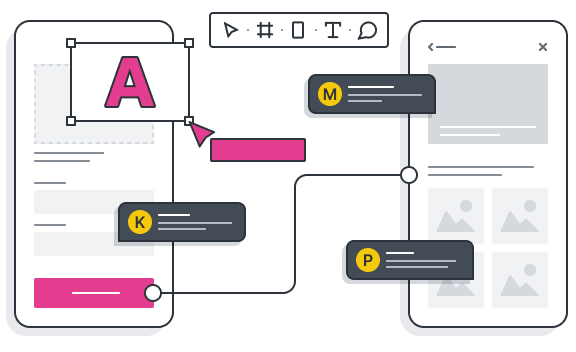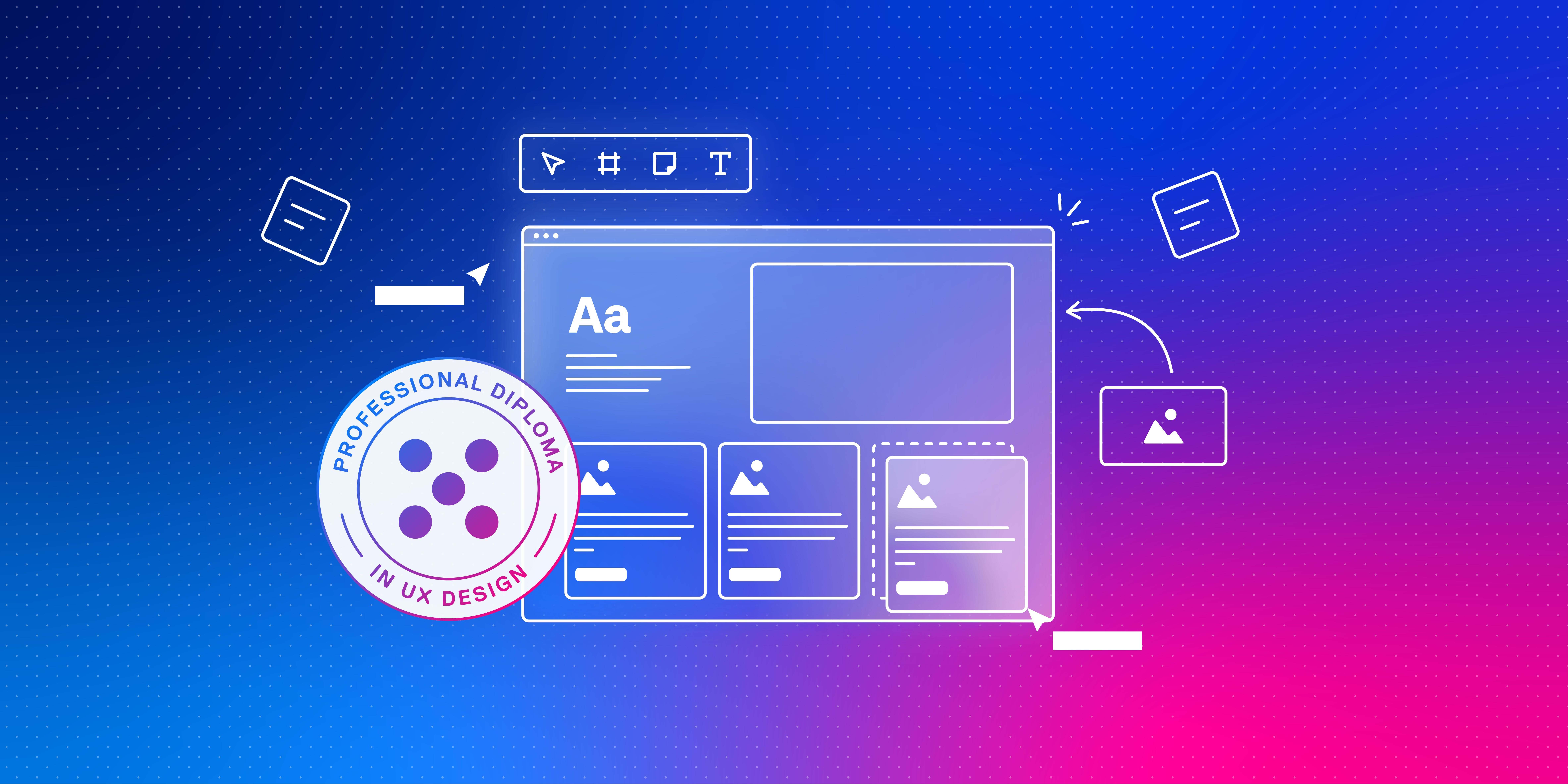A new year inevitably brings with it a wave of new trends—and the UX industry is no exception.
So what are the biggest trends, challenges, and opportunities for UX professionals this year? Where are we at after the initial AI hype, and what will it take to thrive as a designer in 2025 and beyond?
In 2025, we expect the UX design industry to be shaped by:
Let’s explore what each of these trends means—and how UX designers can leverage and navigate them.
1. More thoughtful, value-focused integration of AI
In our UX trends report for 2024, we talked about the rapid rise of AI. This time last year, there was indeed a lot of hype around artificial intelligence—with both excitement and trepidation about what that might mean for designers.
As far as UX design trends go, 2025 marks a turning point for how AI is perceived in the UX industry. Now, with more hands-on experience, UX professionals have a clearer, more realistic picture of AI’s strengths and limitations.
We’re essentially moving beyond the initial hype towards more thoughtful, value-driven integration of AI into the UX workflow.
What’s out: Using AI just because it’s there and could potentially do something better or faster.
What’s in: A more selective, critical approach—determining if and how AI tools can add genuine value before bringing them on board.
How to leverage this trend:
Remain critical in your adoption of AI-powered UX tools. Make the most of AI to automate repetitive tasks, support ideation, help with user research analysis, create solid design systems, and enhance accessibility (more on that later!).
At the same time, stay cautious about factual accuracy, bias, and ethics—and never stop applying your own creativity, emotional intelligence, strategic thinking, and human judgement.
Read also: AI and UX—a reality check with Jakob Nielsen.
2. Renewed urgency around accessible design
The best designers know that accessibility is fundamental to good UX. And don’t get us wrong—accessibility should never be considered just a fad or a trend.
But there’s something happening in 2025 that’s bringing some much-needed urgency to the matter: the compliance deadline for the European Accessibility Act (EAA).
So what does this mean exactly?
The European Accessibility Act was brought in to ensure consistency in accessibility requirements across all EU member states. Per the Act, providers of commonly-used hardware and software products must be compliant with Web Content Accessibility Guidelines (WCAG) 2.2, ensuring optimal usability for people with disabilities.
The Act applies to a whole host of apps, websites, and digital platforms across a vast range of sectors—and will hopefully mark a notable shift towards more accessible, enjoyable user experiences.
With the compliance deadline looming, UX designers will be under great pressure to design (and redesign) with accessibility at the forefront. And, beyond the deadline, accessibility must remain a top priority.
What’s out: Treating accessibility as a one-time box-ticking exercise or a superficial afterthought.
What’s in: Embedding accessibility into the very fabric of the design process from start to finish, and treating it as an ongoing endeavour.
Whether or not you’re directly impacted by the European Accessibility Act, make sure you’re integrating accessibility into your design process from the start.
Stay up-to-date with Web Content Accessibility Guidelines (WCAG) 2.2 guidelines, research and test with diverse user groups, and leverage AI where appropriate.
When used with care, AI can be incredibly useful for enhancing accessibility. Look for AI tools that can automate contrast checking, generate alt text, and enhance screen reader compatibility.
And remember: AI is just another tool to support human-led accessibility efforts—not a replacement for thoughtful, inclusive design practices.
3. A greater focus on sustainability and ethical design
We live in the era of awareness. Today’s consumers are wise to deceptive design patterns, and they’re increasingly conscious about sustainability, privacy, and ethical design.
In 2025 and beyond, consumers are raising the bar. User-friendly products are just the bare minimum; designers must also create products that are more environmentally and ethically responsible.
First, the topic of sustainability. With growing awareness around just how much energy digital products consume (spoiler: it’s a lot), the pressure is on for designers to consider the carbon footprint of their work. This means optimising for performance and efficiency to reduce unnecessary data usage.
At the same time, as AI cements itself both within the design process and within user-facing products themselves, the UX industry must make a conscious and meaningful effort to mitigate bias, establish ethical design practices, and prioritise transparency.
Writing about the State of UX in 2025, authors Fabricio Teixeira and Caio Braga express concerns that we’re “trading empathy for algorithms” and “choosing to build for the machine—not for each other.”
But it doesn’t have to be this way.
In the coming years, brands and designers will find themselves at a crucial crossroads: continue prioritizing engagement metrics and AI-driven decisions at the expense of users, or advocate for more human-centered, privacy-first, and sustainable solutions.
Unsurprisingly, those who choose the latter will ultimately win out when it comes to consumer trust and loyalty.
What’s out: Designing purely for engagement and conversions without considering environmental impact, user privacy, or ethical implications.
What’s in: Prioritising low-energy, privacy-first, and transparent design choices that respect both users and the planet.
How to leverage this trend:
This is undeniably a huge topic, and there’s lots that can—and should—be done.
Start by thinking about how you can reduce digital waste, both within your product and behind the scenes. Optimise images, minimise autoplay videos, and limit energy-intensive animations.
From a long-term perspective, build towards lean, performance-efficient design systems and processes that improve the user experience without excessive data consumption.
At the same time, make user privacy a default, not an afterthought. Maximise user control within the product interface, use clear consent mechanisms, and be transparent about how you’re using AI.
Finally, advocate for ethical design within your team. If you’re in a position to do so, push for solutions that build long-term trust over short-term gains.
4. Deeper expertise in research, strategy, and business thinking
As AI tools get more sophisticated—in certain areas, at least—many screen-level design tasks can now be automated. On a day-to-day level, this is great for speed and efficiency.
And, in terms of the bigger picture, it’s driving a steady but sure evolution of the UX designer’s role.
In our 2024 trends report, we predicted that research, critical thinking, and strategic problem-solving would soon become the most important skills for UX designers. In 2025, this trend is even more pronounced.
With AI handling more of the hands-on execution, UX designers must step up as strategic leaders. Strong research and analytical skills will be critical for understanding user mindsets and behaviours, interpreting data-driven insights, and connecting product decisions to business goals.
Ultimately, designers who know when and how to leverage AI while playing to their human strengths will be the ones shaping the future of UX.
What’s out: Focusing solely on screen-level design and UX deliverables without any deeper strategic input.
What’s in: Honing your research and analytical skills and becoming a vision-driven strategic UX leader.
It doesn’t matter if you’re a junior designer at the start of your career or a senior UX expert: you’ve got to keep your skills sharp and relevant.
AI may be great at analysing data, but it’s up to you to ask the right questions, interpret findings, and apply them strategically. So hone your UX research skills and get into the habit of tying your UX decisions to business outcomes.
As you do so, think beyond individual screens, features, and tasks to consider the broader vision. How can you deliver long-term value, both to the end user and the business?
This kind of “vision thinking” will make you an indispensable member of any team.
Want to improve your UX research skills? Check out the UX Design Institute’s Professional Certificate in User Research.
5. A growing demand for UX designers beyond the tech sector
Gone are the days when UX designers worked exclusively in tech. In the midst of large-scale digital transformation, the demand for UX designers is expanding rapidly into non-traditional sectors like healthcare, finance, and government.
According to Gartner, 91% of businesses are engaged in some form of digital initiative. What’s more: by 2027, global spending on digital transformation is projected to reach $3.9 trillion—compared to $2.5 trillion in 2024.
Businesses and organisations are investing big time in digital; all with the goal of improving the end-user experience and boosting operational efficiency.
In healthcare, UX designers are needed to create digital tools that can enhance patient engagement and improve the overall quality of service received.
In finance, the rise of fintech and online banking services is driving demand for skilled designers who can create secure, accessible, and user-friendly platforms.
Then, of course, there’s the upcoming deadline for compliance with the European Accessibility Act (EAA) which applies to a great variety of sectors—not just tech.
The need for talented designers is greater than ever, presenting an exciting opportunity for UX professionals to branch out beyond the traditional tech sector.
What’s out: Limiting UX roles (and your UX job search!) to traditional tech companies and overlooking the importance of user experience in other industries.
What’s in: Embracing UX design as a critical component for success in all company types and sectors.
How to leverage this trend:
Whether you’re looking for your first UX design role or considering your next career move, don’t restrict yourself to the tech sector. Expand your job search to include companies and industries that are embracing digital transformation—and take the opportunity to specialise in a new field.
UX industry trends in 2025: the takeaway
As we head into 2025, UX design is becoming more nuanced, strategic, and far-reaching. We’re moving towards more thoughtful integration of AI—and increasing urgency around accessibility, sustainability, and ethical design.
The role of the UX designer is shifting, too. Designers are expected to bring deeper research expertise and business thinking to the table, while digital transformation is opening up a world of opportunity beyond the traditional tech sector.
The future of UX isn’t just about designing user-friendly products. It’s about solving real user problems, thinking critically, and advocating for more inclusive and responsible digital experiences.
We look forward to seeing how these trends play out—and discovering what else the UX industry has in store for 2025.
For more industry insights, check out the following:
- Your guide to landing a job in UX: top insights from the UX Design Institute’s State of UX Hiring Report
- How to persuade your manager to invest in UX
- How to design for AI-first products: a practical guide




